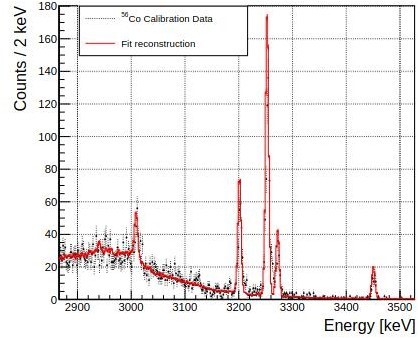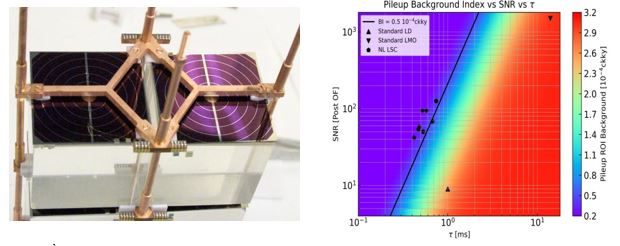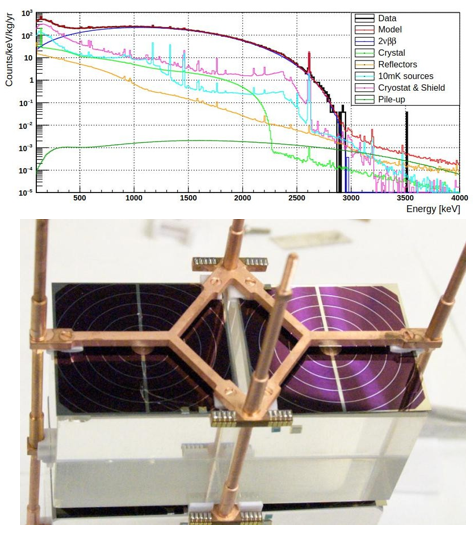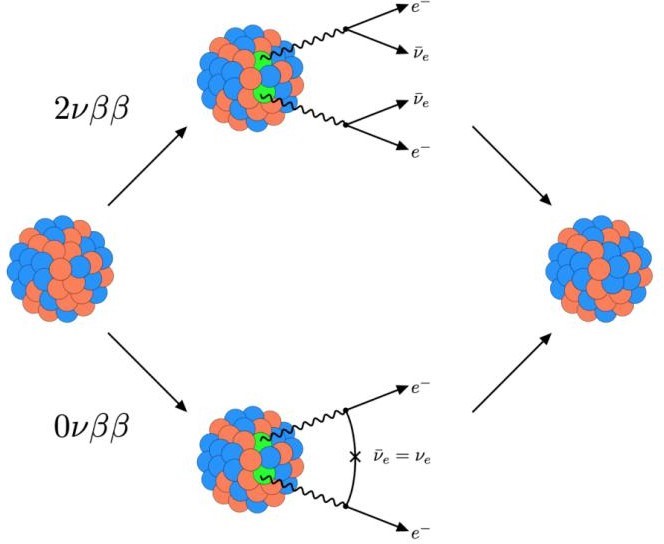Neutrino oscillations have confirmed that these mysterious particles have mass, contradicting the predictions of the Standard Model. The DPhP group at CEA/IRFU is seeking to solve this mystery by observing the very rare double-beta decay without neutrino emission of the Mo-100 nucleus using scintillating bolometers. Following the CUPID-Mo demonstration experiment at the Modane underground laboratory, the group has finalised a detailed background model that offers high precision for studying the 2v2β decay. The model thus achieves the lowest background index ever obtained by the scientific community for a 0ν2β bolometric experiment.
To achieve the target of 10-4 counts/keV/kg/year needed to detect this extremely rare decay, the CUPID experiment has also adopted a new detector technology: Nefanov-Trofimov-Luke (NTL) light detectors to improve background rejection. A measurement, using 10 identical light detectors coupled to Li2MoO4 and TeO2 crystals, was carried out at the Canfranc underground laboratory and demonstrated the applicability of this technology to CUPID detectors. Given the combination of low background, particle discrimination capability, high efficiency and high energy resolution, CUPID is recognised as one of the most promising next-generation 0ν2β search experiments. After a validation review, the experiment will begin its production and construction phase to obtain a complete detector from 2029.
Introduction
In particle physics, neutrinos retain the title of the most mysterious particles of matter. Neutrino oscillations, an unpredicted phenomenon, have confirmed that neutrinos have mass, contradicting the Standard Model predictions. The question of how to define the mass and nature of neutrinos is now crucial to our understanding of particle physics. An extremely rare decay, the neutrinoless double-beta decay, will, if observed, make it possible to fix the neutrino mass scale and establish their nature as a Majorana particle (identical to its antiparticle).
The DPHP group at CEA IRFU is working on one of the leading techniques in this field, using scintillating bolometers to search for the double beta decay of Mo-100. Thanks to the double readout of signals from the heat and light channels, we are able to completely discriminate the alpha background from the region of interest.

Figure 2: Comparison between the 56Co calibration data and MC simulations close to the 100Mo transition energy (Q??W=3034 keV).
Background model for the CUPID-Mo demonstrator
The CUPID-Mo demonstrator experiment at the Modane underground laboratory has been completed. Previous results on the search for neutrinoless double beta decay are presented here.
The group has recently finalized the detailed background model, describing precisely all features of the experimental data and providing high precision for the study of 2ν2β decay and other processes. Thanks to the dual readout of the CUPID-Mo detectors (heat and light signals), this powerful tool is used to completely reject alpha contamination from the region of interest. Event selection also uses other parameters such as multiplicity, delayed coincidence and signals in the muon veto. Thanks to these features, the background index, obtained by CUPID-Mo in the region of interest, is the lowest for a 0ν2β bolometric experiment worldwide:
BI=2,7+0.7 (stat)+1.1-0.6 (syst)× 10−3-0.5 coups/keV/kg/an.
The model, including gamma and beta backgrounds, was built in the Bayesian framework with an MCMC approach (Markov chain Monte Carlo). To test the accuracy of the background model, a measurement was made with a Co-56 source. The simulation shows very good agreement with the data, confirming that the simulation of the experimental set-up is accurate. The model fit is constructed with a total of 67 sources, including bulk and surface contamination and pile-up events.
These results confirm once more the prospects for bolometric searches for neutrinoless double beta decay, in view of ton-sacle next-generation experiments. Thanks to these excellent results, the CUPID-Mo technology has been chosen as the reference for CUPID, an experiment that will include ~1500 Li100MoO4 dual readout scintillating bolometers and 240 kg of 100Mo, currently under development.
Improved light detectors for better background discrimination
Thanks to a major contribution from the French part of the collaboration, the CUPID (CUORE Upgrade with Particle IDentification) experiment has recently adopted a new detector technology. Nefanov-Trofimov-Luke (NTL) light detectors will enhance the signal output. This increase will considerably improve pile-up background rejection, enabling us to achieve the experiment's target of 10-4 counts/keV/kg/year. Each component of the total CUPID background has been carefully evaluated, and one of the most prominent is the contribution of random coincidences of 2ν2β events. This background must therefore be reduced as much as possible, and the proposed solution with improved light detectors allow to comply with the stated goal, reducing the pile-up contribution to 0.5 10-4 counts/keV/kg/yr.
These light detectors are operated as charge-to-heat transducers: the heat signal is linearly increased simply by changing a voltage applied to special metal electrodes, fabricated onto the germanium absorber, and read by a thermal sensor.
Recently, a measurement with 10 identical light detectors, coupled to Li2MoO4 and TeO2 crystals, was performed at the Canfranc underground laboratory. The study of the performance and pile-up rejection has demonstrated the applicability of this technology to CUPID detectors. The results, presented at the collaboration meeting, were approved and it was decided to select the Nefanov-Trofimov-Luke light detectors as the new baseline for the CUPID experiment design.

Figure 4. Left: two Neganov-Trofimov-Luke light detectors on Li2MoO4 crystals. The grey circles represent the electrodes for the voltage bias application. Right: distribution of the light detector parameters, namely signal-to-noise ratio and rise time, as a function of the background index from pile-up events.
Credit : collaboration Cupid
The CUPID collaboration is actively preparing the Conceptual Design Report (CDR), including this recent upgrade of light detector technology. Following review and validation of the CDR, the experiment will start its production and construction phase with an array of ~1500 Li2100MoO4 crystals and ~2000 NTL light detectors, with the goal to start the measurements with the full detector in 2029. Given the combination of low background, particle discrimination capability, high efficiency and high energy resolution, CUPID is recognized as one of the most promising 0ν2β search experiments of the next generation.
Contact: Anastasiia Zolotarova, Claudia Nones
• The ultimate constituents of matter › Neutrino Physics
• The Particle Physics Division
• Sources and reactors neutrinos
• LUMINEU






